As I note in the accompanying column to my reviews below, one of the most-discussed changes we’ve seen in the evolution of Eugene Stoner’s original AR-15 — or M-16 in military parlance — has been the move to an external piston to cycle the action.
For further details on the important elements to the piston-driven AR system — along with their associated benefits — in comparison with the traditional, direct impingement systems, check out that column here. In this space, however, I want to summarize my observations from testing several piston-driven AR systems from Barrett, Primary Weapons Systems, Lewis Machine and Tool, Rock River Arms, Ruger, and Sig Sauer.
Let’s get to it, shall we?
LMT CQB MRP Defender Piston

Lewis Machine and Tool has been producing rifles and rifle parts for many years but only entered the piston market recently. In this short time, the LMT CQB Defender Piston has garnered a strong following with users reporting good accuracy, reliability and durability.
The Defender is based on what LMT calls the monolithic rail platform (MRP) upper. The MRP upper features a continuous railed surface that is integral with the upper receiver and takes the place of a separate handguard. In addition to providing an uninterrupted railed surface, the MRP allows for exchange or replacement of the barrel so that the upper can be easily converted from a rifle to a carbine based on the user’s needs. It can also be converted from piston to conventional gas tube operation or to other calibers all while maintaining the same upper receiver.
The LMT is also available chambered in 6.8SPC but barrels for the LMT MRP upper are not interchangeable with uppers from other manufacturers. I am intrigued by this level of adaptability, but did not make use of this feature during my evaluation.
In addition to the use of the MRP upper, LMT is using what’s called an enhanced bolt carrier. The new carrier has a slightly different cam pin slot that adjusts the speed at which the bolt unlocks. This change is said to keep the bolt closed a fraction of a second longer to help ease extraction stresses and is available as a one-piece unit for piston operation or with a mounted gas key for use with a gas tube. Bolt carriers are not interchangeable between operating systems.
During live-fire testing, the LMT performed well and showed good accuracy. Recoil was comparable to a conventional gas tube AR and I liked the time I spent with the LMT piston gun. Operation of the rifle’s controls was smooth and positive. I especially liked the LMT’s stock — its flared sidesmake for a nice cheek weld when using a scope.
The LMT worked perfectly during testing and I experienced no reliability issues. However, I did notice that after firing 360 rounds, the gas block on the barrel was starting to come loose. I returned the barrel to the factory for replacement and the replacement barrel gave no issues whatsoever during the remainder of my testing. After use, the LMT showed just the most minor signs of carrier tilt. I noted nothing alarming in this regard with some cosmetic rubbing at the point where the buffer tubes meet the lower receivers. The wear mark did not progress beyond this superficial point.
Ruger SR-556CLA
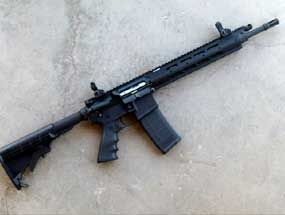
Ruger entered the AR market in 2009 with the introduction of the SR-556. The original model is a complete package and comes with Troy sights, a railed handguard and a set of rail covers. Ruger has since added a carbine (SR-556C) and a 6.8SPC to the lineup.
The SR-556CLA is different from the other offerings in that it has a smooth aluminum handguard rather than the quad railed handguard on the other models. This new smooth handguard is also used on the SR-556E, which is Ruger’s entry level piston rifle.
Ruger’s piston is two-stage and has a small nipple on its face that fits into a recess in the gas regulator. This nipple is a piston on top of a piston and provides the initial power stroke to get the Ruger’s action moving. Once the nipple clears its interface in the regulator, the gasses dissipate slightly and provide a gentle push for the rest of the piston’s stroke. Ruger says this system creates less wear and tear on the gun and helps create a soft recoil impulse. Ruger’s gas regulator has four settings (one is an off position) that can be adjusted depending on operating environment.
The SR-556CLA, like the other Ruger piston guns I’ve shot, is surprisingly accurate and was one of the more accurate rifles tested, handling Hornady 75gr ammo with no issues despite the 1x9 barrel twist. The addition of the new smooth handguard drops the CLA’s empty weight to just over seven pounds with the included Troy sights.
The CLA’s chrome-lined barrel is just over 14 inches long. To keep things legal, Ruger chose to machine an integral flash hider to the barrel to bring the overall length to 16 inches. This means the flash hider isn’t removable without cutting the barrel and permanently installing a different muzzle device. In addition, the integral flash hider on the CLA wasn’t compatible with the Gemtech HALO.
To give the user some flash hider options, I would have preferred that Ruger use a conventionally-threaded 16” barrel. Another feature I’d like to see incorporated into the design is an easily removed transfer rod. Ruger said that, during pre-production testing, they found no need to access this part for cleaning or maintenance. This may be true, but it would still be nice to remove the rod for inspection without tools and/or returning the upper to the factory.
But nothing is perfect — or perfectly flawed, in this case — and some other designs allowed a little gas to flow back along the rod and into the upper. Not so with the Ruger. The CLA’s upper receiver and bolt parts stayed very clean during testing. Like the LMT, the Ruger showed minor scuffing inside the buffer tube.
Ruger’s piston design is rugged and well executed and should prove to be a very solid entry into what’s becoming a fairly crowded market.
Barrett REC7
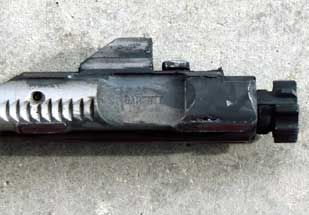
The Barrett REC7 was initially sold only in 6.8SPC and was just recently offered in .223 Remington. Barrett advertises the REC7 as having some of the sturdiest piston components on the market and I’d be surprised if this claim isn’t true.
The gas block is securely mounted to the barrel with two large pins and the block’s interior is fluted to keep the piston parts moving freely even when heavily fouled. The gas plug is locked in place by a captured detent and is easily removed for cleaning and inspection. The REC7’s piston is a stainless steel rod that runs all the way from the gas port to the bolt so there are no separate piston parts to remove and possibly damage or lose. The bolt carrier is coated with a nickel Teflon finish for easy cleaning. The bolt itself has a groove cut behind the locking lugs to help reduce the chances of stress cracks in this area.
At the range, the Barrrett REC7 offered few surprises. Accuracy was very good, with most groups running two inches or less at 100 yards with the Prvi ammunition. The Hornady 75gr ammo produced much more impressive and repeatable accuracy and I was able to shoot several groups of three rounds that were easily under an inch. The railed handguard is free-floated and this minimal contact with the barrel means minimal heat transfer. In fact, the REC7 ran cooler to the touch than some of the other rifles tested.
At just over seven pounds empty, the Barrett balanced well and handled well during live fire. The stock trigger was heavy and crunchy out of the box but did smooth out with some use.
Internally, I noted no signs of unusual wear or carrier tilt. It has been my experience that any tilt wear to the buffer tube will usually be visible within the first couple of magazines. The dust cover latch on the Barrett’s upper fell off about 600 rounds into the testing. This did not affect the weapon at all in a functional way and it was the only broken part experienced. I replaced the dust cover and have had no further issues and believe the failure was related to a defective dust cover rather than any fault of the Barrett design.
I ran the Barrett with the Gemtech HALO attached and ran close to 300 rounds through the rifle with the suppressor attached. With the gas setting set for suppressed use, the Barrett ran like a champ even with the added back pressure. The nickel coated parts soon became black with carbon and soot but they wiped clean with minimal fuss.
Rock River PDS
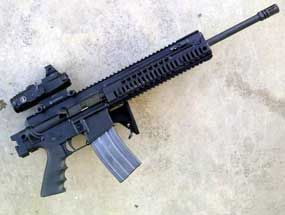
The Rock River Arms PDS (Piston Driven System) is unique in that it’s a different and new design housed within an AR upper and lower. The buffer tube is gone and the action spring is now housed above the bolt carrier and compresses into a tube that extends forward over the barrel. Without the need for the buffer and spring, there’s no need for the hollow receiver tube and it has been replaced with a folding stock.
Really, the only parts that remain unchanged are most of the lower receiver parts (the lower receiver is NOT interchangeable with a conventional AR lower) the bolt, firing pin and extractor. The PDS is available with two different handguard configurations (railed and non-railed) and also as a pistol. RRA is also looking into making a factory short barreled rifle that should be released in the near future.
On the range, the RRA is unique in that it recoils like none of the other rifles tested. Since the bolt carrier’s center of gravity is moved out over the barrel, there’s no shift of mass into the stock. The recoil impulse is sharper than that of a conventional AR but it’s very flat and smooth and easy to handle and I believe it feels much like the FN SCAR-16S in this regard.
With the removal of the buffer tube, the issue of carrier tilt has been eliminated although the possibility of some offset internal forces still exists. I did speak to one of Rock Rover’s engineers about this and he told me that they’ve got a sample at the factory that has been through close to 25,000 rounds with no appreciable wear or broken parts.
Accuracy with the PDS was good. Most groups fired from the bench ran in the one and one half inch range with match ammo. The PDS comes with Rock River’s national match trigger installed from the factory. One thing to note here is that the top rail of the PDS is slightly higher than that of a conventional AR. This might be a concern to those who are used to shooting an AR-15 with a certain cheek weld since it will place optics and iron sights on a slightly higher plane over the rifle’s bore.
On the downside, I found the forward mounted non-reciprocating cocking handle small and hard to operate. The forward mounted handle also limits the utility of the rifle’s railed handguard and the user might not be able to operate the handle properly depending on what accessories are mounted to the rails.
Rock River does not recommend using a suppressor on their piston system and I did not use the HALO during my testing of the PDS.
Primary Weapons Systems MK116
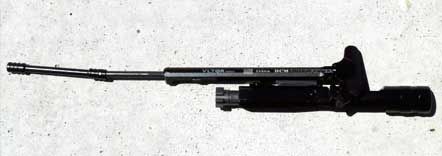
Primary Weapons Systems (PWS) entered the piston market a few years back with their piston conversion system. This conversion was offered as a retrofit kit to existing upper receiver assemblies. Unlike most conversion kits, Primary Weapons did not sell their parts to individual users.
Those wishing to have the PWS piston installed had to send their upper to PWS or one of their authorized distributors. The piston system, as originally sold, consisted of a long rod that replaced the traditional gas key. This rod ran most of the length of the barrel and interfaced with a gas piston that was housed inside a gas block. This system was available for a number of years but was eventually phased out in favor of a system that is drawn heavily from the gas system of the AK47.
Gone is the separate piston housed inside a small gas block. PWS now uses a long gas tube that runs from the gas port to the upper receiver. This tube not only houses the piston rod but it serves as the top rail for the rifle’s railed handguard. Inside this tube is a long piston that is pinned to a rod on the bolt carrier. This new system eliminates the gas plug or separate gas regulator found on most other systems and greatly simplifies the PWS design.
As originally launched, the PWS system was available only as a factory-complete upper, but is also now available as a complete rifle. PWS offers piston rifles and uppers chambered for 223 Remington, 7.62x39, 300 Blackout and .308 Winchester. In addition to different calibers, the PWS rifles are also available in a variety of barrel lengths.
The MK116 sent for evaluation was the lightest rifle tested with a manufacturer’s listed weight of less than seven pounds. The gun is extremely well balanced, felt very lively in my hands, and was easy to swing from target to target. Off the bench, my best group was five rounds of match ammo into just over an inch. Certainly well within any accuracy parameters that one can reasonably expect from a patrol carbine.
Being that the gas tube is open and connected directly to the upper receiver, I did note that there was more carbon on the bolt and bolt carrier than with some of the other piston guns, especially with a suppressor attached. Still, internally, the PWS runs cleaner than a traditional gas AR.
For me, a bigger concern was the heat generated during firing. Since the gas tube is also the handguard’s top rail, those shooters who shoot with a thumb-over hold will probably have to modify their shooting grip or wear gloves as the top rail became hot after several magazines of rapid fire. The gas system on the MK116 is not adjustable and I had several stovepipe malfunctions when running suppressed. It is my belief that a heavier buffer would be a necessity if the gun were to be used suppressed on a regular basis.
Noted firearms trainer and US Army veteran Paul Howe has now partnered with PWS and is endorsing this system. I was able to visit with Paul at the 2012 SHOT Show and we spoke at length about the MK116 rifle. Paul had recommended a piston rifle from another maker previously but withdrew his endorsement over quality control issues. I respect Mr. Howe’s service and experience and his support speaks volumes about PWS as a design and a company.
Sig Sauer SIG516 Patrol
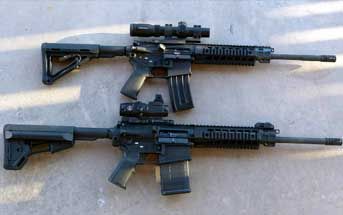
Sig Sauer is another recent contender to the piston market with their SIG516. The 516 Patrol first hit the market in late 2009 and uses a 1x7 twist chromed barrel surrounded by a railed free-floating handguard. Sig has now started shipping the 516 Basic Patrol which uses a round M4 style plastic handguard rather than the aluminum railed handguard. Unlike the other rifles tested, the SIG516 uses a lower receiver that’s machined from a solid billet of aluminum. This gives the rifle blocky but modern lines and the lower features an ambidextrous magazine release and integral QD sling swivel mounts.
The 516’s gas system is adjustable and has three settings. One is a minimum gas setting for running suppressed; the next setting is the standard setting for most uses. The third setting is an “over gas” setting to operate the gun when very dirty. Sig also sells a version that has a gas cutoff position. The gas valve is easy to adjust and change from one setting to the other but the valve is threaded into the gas block.
This makes the system somewhat more difficult to take apart and I found the valve difficult to unscrew once it got a little dirty. Inside the rifle’s handguard are the gas piston parts. These are assembled as a complete unit and the entire assembly is removable from the front of the gas block. Another interesting feature is the fully-supported extractor. Sig uses a small stud inside the barrel extension that limits extractor travel — and supposedly limits extractor related failures.
The SIG516’s accuracy was good and it had the best stock trigger of all the guns tested. The trigger, while a little heavy, broke with no perceived drag or creep. The rifle’s recoil impulse was a little sharper than some of the other guns, possibly due to the weight of the system’s reciprocating piston parts but it certainly wasn’t anything unnerving or unmanageable.
Sig also sent their new seven inch PDW upper for evaluation. This upper is very much like its 16 inch brother but requires that it be used on a registered short-barreled rifle or pistol lower for legality. I found the PDW upper very fun and easy to shoot and had no reliability problems with the short barrel and abbreviated gas parts even when suppressed. Sig will be selling the PDW as a complete SBR and pistol in the very near future. Even with the abbreviated barrel, I had no problem hitting a man sized target at distances of 200 yards. Sig is also offering a ten inch variant called the SIG516 CQB but this was not available during testing.
Neither of these uppers showed signs of carrier tilt wear on their respective buffer tubes.
Sig Sauer SIG716 Patrol
Released for SHOT 2012 is a brand new model of piston AR from SIG. Continuing with the genesis of their 223 Remington offerings, SIG has now beefed up their piston gun and chambered it in 308 Winchester. This new model is dubbed the SIG716 and is based on the standard AR-10 platform but with a piston rather than a traditional gas tube.
The new rifle uses the inexpensive and readily obtainable PMAG 308 magazines. SIG recently sent me one of these new rifles for review and I will be taking an in-depth look in the near future. My initial impressions are very positive and I look forward to running this new rifle.
Final Analysis
Of the rifles tested, did I have a favorite?
Yes. I give high marks to the LMT, Barrett and the SIG designs.
These have simple yet sturdy operating systems and offer straightforward disassembly for cleaning. I like that the SIG and Barrett guns have removable handguards that make detailed cleaning a simple task. The PWS MK116 was the lightest and best balanced rifle and would be hard to pass if weight is a major concern.
I know that my own personal preferences and prejudices cloud my judgment and realize that it’s naive to think that firing several hundred rounds through any one of these rifles would be a true test of durability and reliability. I only wish I had more time to spend on each of these rifles while we try to find the final answer to the continuing debate.


